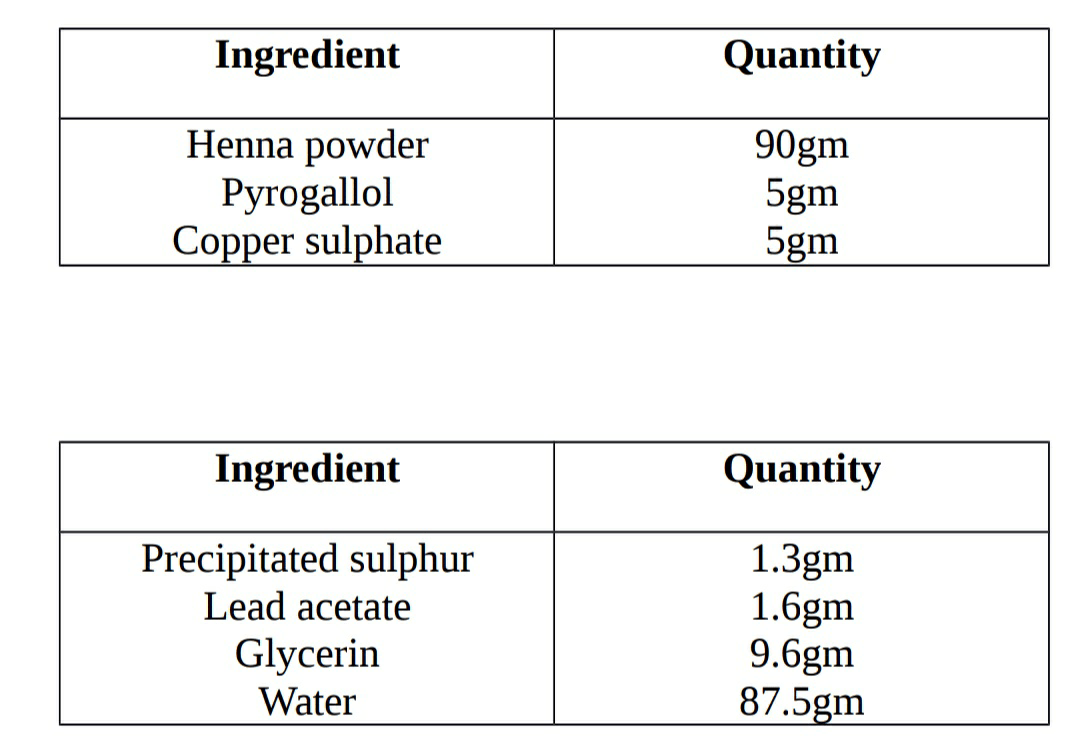It is derived from a greek word “Kosmeticos” Which means “to adorn”. Cosmetics may be defined as any article intended to be rubbed, poured, sprinkled, sprayed on human body for cleansing, beautifying, promoting attractiveness or to change the appearance of the body is called as cosmetics.
Classification of cosmetics:
Cosmetics may be classified on the basis of site of application:

COLD CREAM:
Cold cream is a W/O type emulsion which produces a cooling effect on application to skin due to slow evaporation of water present in it. Cold cream is generally used in winters. It is produced by saponification reaction between bees wax and borax. Borax reacts with free fatty acids of bees wax and form soap which acts as emulsifier for preparation of cream.
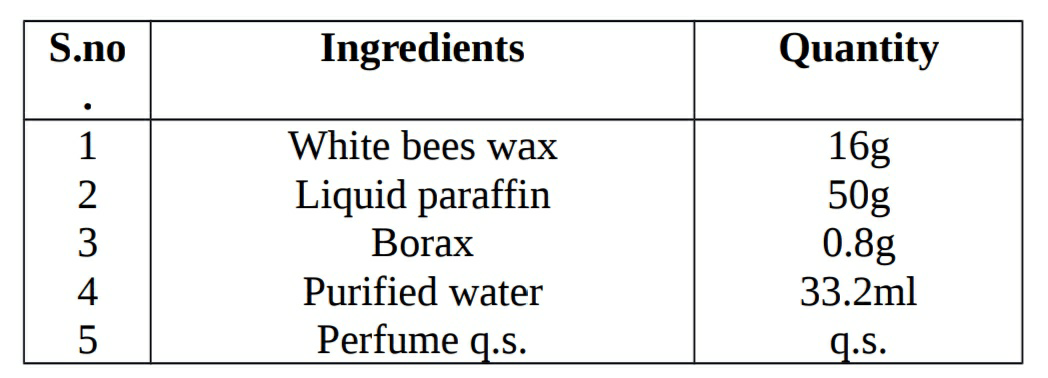
Procedure:
- Melt the white bees wax and liquid paraffin upto 70˚c on a water bath to obtain a melted mass.
- Dissolve the borax in purified water and heat it upto same temperature as that of melted mass.
- Then add this aqueous solution in melted mass drop by drop with continuous stirring.
- Stir continuously until temperature reaches below the 30˚c or it becomes cool.
- Then add perfume and mix uniformly until a homogeneous product is form.
VANISHING CREAM:
Vanishing cream is a o/w type emulsion, which when applied to the skin, it vanishes and leaves an almost invisible layer on it. Hence it is called as vanishing cream. The layer behind after application acts as foundation for the facial make up. The main ingredients of vanishing creams are stearic acid, alkali and water. Stearic acid gives a pearly appearance to the cream. Soap is prepared by reaction between stearic acid and alkali which acts as emulsifier for the preparation of the cream.
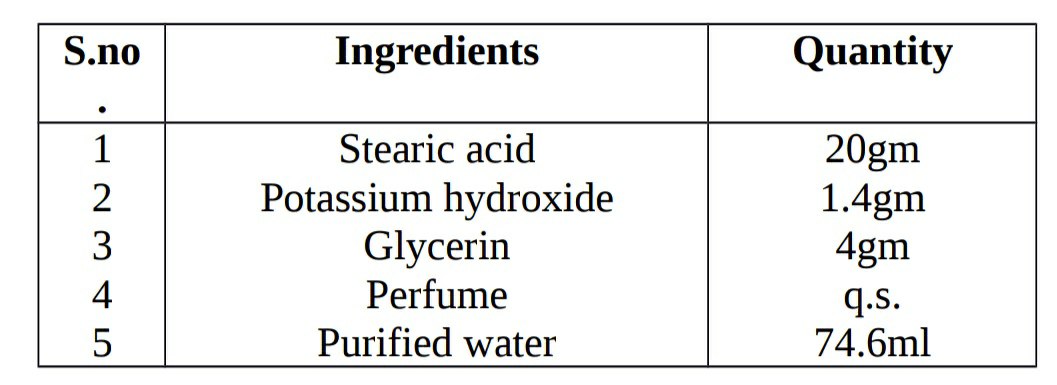
Procedure:
- Melt the stearic acid on water bath at 70˚c.
- Dissolve the potassium hydroxide in purified water, add glycerin to it.
- Heat this aqueous solution on water bath at 70˚c.
- Then add this aqueous solution to the melted stearic acid drop by drop with continuous stirring.
- Stir continuously until temperature reached below than 30˚c.
- Then add perfume and mix well until a homogenous product is form.
Evaluation parameters:
- pH determination
- Visual inspection
- Spreadability
- Rheological studies
- Skin irritation test
- Stability studies
- Thermal behavior
SUNSCREENS:
These are the cosmetic preparations used to prevent or minimize the harmful effects of the solar radiations on the skin. It is an efficient method of protecting the skin against UV radiations.
Formulation:
Active ingredients:
These are classified as organic and inorganic chemicals.
Organic chemicals:
These agents absorb ultraviolet light. These agents include cinnamates, PABA, salicylates, benzophenones, camphor derivatives etc. Cinnamates, PABA, salicylate and camphor derivatives are generally UVB absorbers while benzophenone, anthranilates etc are UVA absorbers.
Inorganic chemicals:
These agents reflect, scatter and absorb UV light. These agents include titanium dioxide, zinc oxide or combination of both. These are generally used in combination with organic chemicals.
SHAMPOO:
It is a cosmetic preparation which is used to remove or clean the dirt, grease, or any other impurity from the hair shaft without causing the adverse effect.
Requirement of a ideal shampoo:
• It should remove dirt, soil, fatty material, sebum secreted from the hair and scalp.
• It should provide sufficient lustrous to the hair after use.
• It should provide sufficient fragrance to the hair after use.
• It should be easily remove from the hair with water.
• It should produce sufficient foam in hard and soft water.
• It should make the hair soft and shiny.
• It should be non-toxic and non-irritant.
Formulation:
Detergent:
These are used in shampoos to clean the dirt, dust, grease etc from the hair shaft and scalp. These make up the 10-15% of the total formulation. These are also called as surfactants. Example:
Sodium lauryl suphate (SLS),Polyethylene glycol etc.
Foaming agents:
These are other type of surfactant used in shampoos to produce the foam in sufficient Example: Lauramide DEA.
Thickeners:
These agents are added in shampoos to increase the viscosity of the shampoos. Example: Methyl cellulose, Sodium carboxymethyl cellulose etc.
Conditioning agents:
These agents are used to improve the condition of the hairs or to provide smoothness and softness to the hair. Example: Lanolin, egg yolk, Dimethicone, Quaternium 80 etc.
Sequestering agents:
These agents are added to prevent the deposition of calcium, magnesium salts present in water by complex formation. Example: EDTA.
Preservative:
These agents are added to prevent or inhibit the growth of microorganisms in the shampoos.
Example: Phenylmercuric nitrate, Methyl paraben, Benzoic acid etc.
Antidandruff agents:
These agents are added to prevent the formation of scales on the skin under the hair. Example:Cetrimide, Benzalkonium chloride etc.
Coloring agents:
These are added to provide the desired color to the shampoos. Example: Tartrazine yellow
Perfumes:
These are added to provide fragrance to the shampoo. Example: Lavender oil, Jasmine oil etc.
Evaluation of shampoo:
Visual inspection:
The prepared shampoo is visually inspected for determination of clarity, foaming ability and fluidity.
pH determination:
The pH of 10% solution of prepared shampoo in distilled water is determined by digital pH meter at room temperature.
Test for foaming qualities:
A fixed volume of prepared shampoo solution and standard shampoo is taken into two different cylinders and shaken for 5 minutes. The foam volume is measured and the rate at which foam collapses is noted. Then prepared shampoo is compared with standard shampoo.
Determination of percent of solid content:
4 grams of prepared shampoo is placed in cleaned, dried chine dish and placed on hot plate until liquid gets evaporated. Then weight of shampoo after drying is reweighed.
Wetting test:
Water is taken in a measuring cylinder and prepared shampoo solution is taken into another cylinder. The weighed amount of cotton is placed in both cylinder and time taken to sink the cotton in bottom is noted. The time taken for sink the cotton in water may be more than 8 hours but it may sink within few seconds in shampoo solution due to presence of detergent.
Surface tension measurement:
Surface tension of prepared 10% shampoo solution is measured using the stalagmometer.
Eye irritation test:
About 1% prepared shampoo solution is applied into the eyes of albino rabbits and changes like redness, patches etc are noted in the eye of rabbit.
Stability studies:
Stability studies of prepared shampoo is carried out by placing it at elevated storage conditions 45°c and 75% RH for 3 months and at every 1 month it is inspected.
DENTIFRICES:
These are the agents which are used to clean the accessible surfaces of the teeth with the help of the tooth brush. These may be medicinal or non-medicinal. These are available in powder and
paste form and generally tooth paste is used.
Formulation:
Abrasives:
These are the agents which are added to clean the surfaces of teeth or to remove plaque, debris etc from the teeth. These are also called as polishing agents. These are major part of any dentifrices and constitute around 50% of a formulation. Example: Calcium carbonate, Dicalcium
phosphate dihydrate, Calcium pyrophosphate, sodium metaphosphate etc.
Surfactants:
These are added in dentifrices to provide foams in sufficient amount during use. Example:
Sodium lauryl sulphate.
Binder:
These agents are added to bind various ingredients of the tooth paste. Example: Tragacanth, Methylcellulose, xanthan gum, Carboxymethylcellulose etc.
Humectants:
These are added in formulation to prevent the dryness of the tooth paste or to maintain the moisture of the tooth paste. Example: Glycerin, sorbitol etc.
Sweeteners:
These agents are added in formulation to provide sweetness to the formulation. Example; Sodium saccharine, sucralose etc. These are generally used at concentration below 0.5%w/w.
Coloring agents:
These are added in formulation to provide desired color to the formulation, Whiteness is achieved by use of titanium dioxide, while artificial colors are used at cocnetration below 0.1%w/w.
Preservatives:
These are added in formulation to prevent o inhibit the growth of microorganisms. Example: Methyl paraben, Sodium benzoate etc. in concentration less than 0.1%w/w.
Flavors:
These are added in formulation to provide fragrance or to mask the unpleasant smell of surfactant and to provide refreshing breathing in mouth. Example: Mint flavor, menthol at concentration of 0.3-2%w/w.
Water:
It is added in formulation as a vehicle or solvent or to disperse various ingredients of the formulation.
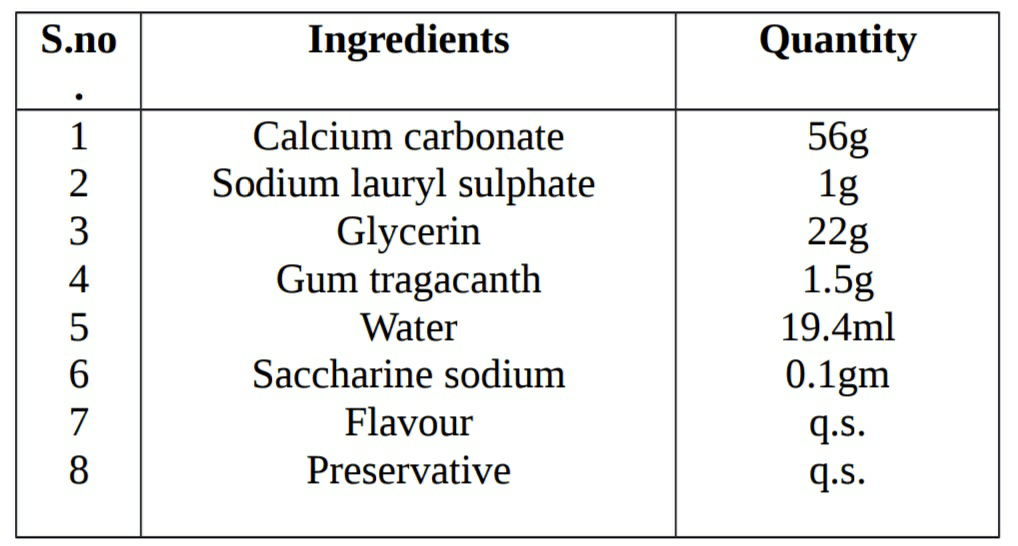
Evaluation:
Physical examination:
Color, odour, taste etc of the prepared formulation are examined by visual inspection.
pH:
The pH of 10% solution of prepared formulation in distilled water is determined by digital pH meter at room temperature
Foamability:
Take small amount of preparation in measuring cylinder and note its initial volume. Then shake it for 10 times and again note the volume.
Spreadability:
The prepared tooth paste is placed between two glass slides. The upper glass slide is movabe and lower glass slide is fixed. A fixed weight is added to upper slide to slide the slide over the lower slide and the weight required to move the upper slide over the lower slide having preparation.
Determination of volatile matter:
Take 5gm of formulation in chine dish and heat it in hot air oven at 105°c and then calculate it using the formula:
by mass= Loss of mass ondrying / Intial mass of material
Stability studies:
Stability studies of formulation is carried out by placing it at elevated storage conditions 45°c and 75% RH for 3 months and at every 1 month it is inspected.
LIPSTICK:
• Lipstick is a cosmetic preparation which is used to give an attractive colour, glossy and moist appearance to the lips.
• These are basically dispersions of colouring matter in a base having blend of oils, waxes suitably perfumed, moulded in the form of a stick.
Essential characteristics:
A lipstick should have following characteristics:
• It should cover the lips properly with some gloss and last for long time.
• It should make the lips soft.
• The film must adhere to the lips without being brittle or hard.
• It should have high retention of colour intensity without any change in shade of colour.
• It should be non-toxic and free from gritiness.
• It should be non-irritating to the lips.
• It should be non-drying.
Formulation of lipstick:
A lipstick has following ingredients:
- Wax mixture
- Oil mixture
- Bromo mixture
- Colours
- Preservatives, fragranc, surfactant etc.
Wax mixture:
Wax is used to provide hardness and glossiness to the lipstick. It depends on characteristic and quantity of waxes used. A mixture having waxes of different melting points is used for lipstick.
Various waxes used are:
- White bees wax
- Candelilla wax
- Carnauba wax
- Ozokerite wax
- Ceresin wax
- Cetyl alcohol
- Oils:
- A mixture of oil is used to blend waxes properly to provide a suitable film on the lips. It also act as solvent for insoluble colour pigments. An ideal mixture is one which provides the product having good spread ability and produces a thin film with good covering power on the lips.
- Various oils used in lipstick are:
- Castor oil
- Tetrahydrofurfuryl alocohol and its esters
- Paraffin oils
- Isopropyl myristate
- Isopropyl palmitate and butyl stearate
- Bromo mixture:
The bromo mixture is a solution of the dyestuff in a fatty material so that dyestuff remain in solution. The dyestuff consist of fluoresceins, halogenated fluoresceins and other water insoluble dyes. Generally 2-3% of bromo acid is sued in castor oil and butyl stearate mixture. Bromo acids
are of two types:
- which are red and gives a red or reddish blue stain.
- Second which are orange, red and gives a pink to yellowish-pink stain.
- Colours:
• These are the agents which provide desired colour to the lipstick. In older days, caramine was sued as colour pigment in lipstick but now a days lots of dyestuffs are and lakes are
available.
• The colour in given into two ways:
• By staining the skin with a solution of dyestuff which penetrate the outer layer of the lip skin. It is provided by soluble dyes.
• By covering the lips with a coloured layer which hide any skin roughness or give a smooth appearance. It is provided by insoluble dyes and pigments.
• Modern lipstick has both types of colours to achieve the combined effect.
• The colours certified under the Drugs and cosmetics act are used in the lipstick which are categorized in following:
Staining or soluble dyes:
Fluorescein, eosin and halogenated fluorescein etc. are used as staining dyes .
Insoluble dyes:
Calcium, barium, strontium lakes etc. are used in formulation of lipstick. These are found in powder form and used in 10-15% concentration depending on the shade and opacity of the film.
• Titanium dioxide in concentration of 1% is also used for increasing the brightness, obtaining the pink shade or to give opacity to the film on lip.
Preservatives:
These are the agents which are used to prevent the growth of microbes in lipstick.
Example: Propyl parahydroxybenzoate (0.1%), concentration above 0.2% may cause burning sensation on the lips and lead to allergic reactions.
Perfumes:
These are used to mask the odour of the fatty or wax material as well as to give attractive flavor to the lipstick. These are sued in concentration of 2-4%. Floral and light spicy perfumes are generally used in lipstick. Perfumes should be stable and compatible with other ingredients of the lipstick.
Antioxidants:
These are used to prevent the rancidification of the oily or fatty material during storage.
Examples:
BHA (Butylated hydroxyanisole), propyl gallate, Citric acid etc.
Surfactant:
These are used to wetting ans stabilizing the dispersion of insoluble pigments in the base.
Others:-
• Oil soluble sunscreens are used t filter the sun rays and protect the lips from sun burn.
• A silicon fluid is used as fixative to prevent colours from bleeding on the lips.
• Isopropyl linoleate is used to prevent dring of the lipstick.
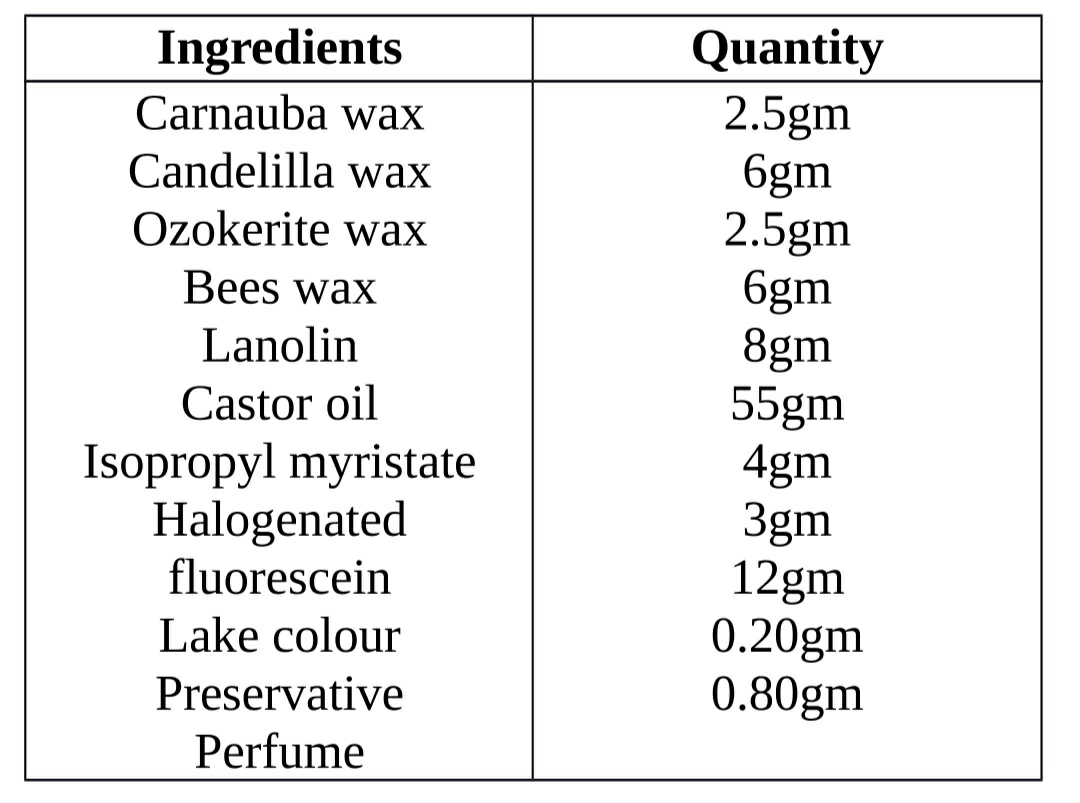
Evaluation:
Following evaluation parameters are used for lipstick:
Melting point determination:
It is determined by capillary tube method. Capillary filled with lipstick is placed in capillary apparatus and the temperature at which it starts to melt is noted. It is an indication of safe storage.
Breaking point:
It is done to check the strength of lipstick. The lipstick is held horizontally in a socket 1/2inch away from the edge of support. The weight is increased by a specific value (10gm) at specific intervals of 30seconds and weight at which breaking occur is considered as breaking point.
Thixotrophy character:
It is done by using penetrometer. A std. needle of specific diameter is allowed to penetrate for 5 seconds under a 50gm load at 25°c. The depth of penetration is measurement of thixotrophy character.
The product is stored at 40°c for one hour. Various parameters like bleeding, crystallization of wax on surface and ease of application are observed.
Solubility test:
The product is dissolved in various solvents to determine the solubility.
Surface defects:
Surface defects like formation of crystals on surface, contamination by moulds, fungi etc. are observed.
pH : pH of the product is determined using the digital pH meter.
Skin irritation test:
It is checked by applying the product on animal skin for 10minutes. If any type of irritation is caused then it is considered that product is irritant.
Stability studies:
Stability studies are carried out by accelerated stability studies as per ICH guidelines.
Hair colorants or hair dyes:
These are the cosmetic products which are used to change the color of hair or to color the gray hair. It is more common in women. There are some side effects of hair dyes like allergic reactions, dermatitis, urticaria, rhinitis, asthma and photosensitivity reactions etc.
These are of three types:
- Temporary hair colorants
- Semi-permanent hair colorants
- Permanent hair colorants
Temporary hair colorants
These hair colorants remove from the hair after first shampooing. These particles do not penetrate the cuticle layer and remain adsorbed on the hair shaft. These colors are generally used for fashionable purposes.
- Semi permanent hair colorants:
These colors are removed from the hairs completely after 4-5 shampooing. These are more preferred because have less risk of damage to skin and hair than permanent hair colorants. These colorants have reduced or no amount of developer (ammonia, hydrogen peroxide) like in permanent colorants hence remove from hair after some washings and do not cause any allergic reaction.
- Permanent colorants:
- These are used to intensify the natural color of hairs or to change the color of hair permanently. These colorants generally use a chemical reaction. Permanent hair color generally contains ammonia and must be mixed with a developer or oxidizing agent in order to permanently change hair color. Ammonia is used to open the cuticle layer so that the developer and colorants together can penetrate into the cortex.
- Formulation of Hair dyes:
- Coupling bases: P-phenylenediamine, p-aminophenol
- Reaction modifiers: These chemicals stabilize the dye pigments or modify the color shades.
- Example: Resorcinol
- Alkalizing agents: These are used to promote the proper pH value for starting of oxidation reaction. Example: Ammonia
- Reducing agent: These are used in oxidative dyes to prevent the reaction between the bases and reaction modifiers in the packaging tube during storage.
- Antioxidants: These are used to prevent the reaction of dye with oxygen air. Example: Sodiums ulfite
